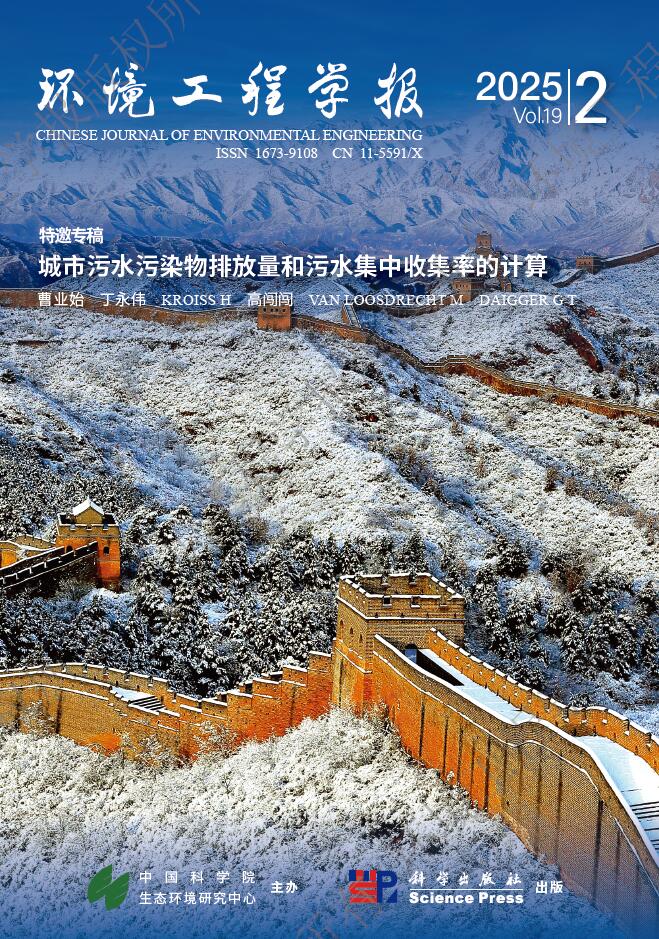|
[1]
|
郭彦海, 袁孙许, 超袁, 等. 上海某生活垃圾焚烧厂周边土壤重金属污染特征尧来源分析及潜在生态风险评价[J]. 环境科学,2017,38(12):5262-5271 10.13227/j.hjkx.201704113
Google Scholar
Pub Med
|
|
[2]
|
环境保护部, 国土资源部. 全国土壤污染状况调查公报[J]. 中国环保产业,2014,36(5):10-11
Google Scholar
Pub Med
|
|
[3]
|
LI Z Y, MA Z W, KUIJP T J V D, et al.A review of soil heavy metal pollution frommines in China: Pollution and health risk assessment[J].Science of the Total Environment,2014,468-469:843-853 10.1016/j.scitotenv.2013.08.090
Google Scholar
Pub Med
|
|
[4]
|
周雅, 毕春娟, 周枭潇, 等. 上海市郊工业区附近蔬菜中重金属分布及其健康风险[J]. 环境科学,2017,38(12):5292-5298 10.13227/j.hjkx.201702104
Google Scholar
Pub Med
|
|
[5]
|
KOPTSIK G N.Modern approaches to remediation of heavy metal polluted soils: A review[J].Eurasian Soil Science,2014,47(7):707-722 10.1134/S1064229314070072
Google Scholar
Pub Med
|
|
[6]
|
DADA E O, NJUKU K L, OSUNTOKI A A, et al.A review of current techniques of in situ physic-chemical and biological remediation of heavy metals polluted soil[J].Ethiopian Journal of Environmental Studies & Management,2015,8(5):606-615 10.4314/ejesm.v8i5.13
Google Scholar
Pub Med
|
|
[7]
|
CHIBUIKE G U, OBIORA S C.Heavy metal polluted soils: Effect on plants and bioremediation methods[J].Applied and Environmental Soil Science,2014,2014:243-254 10.1155/2014/752708
Google Scholar
Pub Med
|
|
[8]
|
许剑臣, 李晔, 肖华锋, 等. 改良剂对重金属复合污染土壤的修复效果[J]. 环境工程学报,2017,11(12):6511-6517
Google Scholar
Pub Med
|
|
[9]
|
HORIKAWA T, KITAKAZE Y, SEKIDA T, et al.Characteristics and humidity control capacity of activated carbon from bamboo[J].Bioresource Technology,2010,101(11):3964-3969 10.1016/j.biortech.2010.01.032
Google Scholar
Pub Med
|
|
[10]
|
BEN-DOR E, BANIN A.Near-infrared analysis (NIRS) as amethod to simultaneously evaluate spectral featureless constituents in soils[J].Soil Science,1995,159(4):259-270 10.1097/00010694-199504000-00005
Google Scholar
Pub Med
|
|
[11]
|
MATSUNAGA T.A temperature-emissivity separation method using an empirical relationship between the mean, the maximum and the minimum of the thermal infrared emissivity spectrum[J].Journal of Remote Sensing Society of Japan,1992,42:83-106 10.11440/rssj1981.14.230
Google Scholar
Pub Med
|
|
[12]
|
MORRA M J, HALL M H, FREEBORN L L.Carbon and nitrogen analysis of soil fractions using near-infrared reflectance spectroscopy[J].Soil Science Society of America Journal, 1991,55(1):288-291 10.2136/sssaj1991.03615995005500010051x
Google Scholar
Pub Med
|
|
[13]
|
MARIA K, RENE G, CECILIE H, et al.Comparing predictive ability of laser-induced breakdown spectroscopy to visible near-infrared spectroscopy for soil property determination[J].Biosystems Engineering,2017,156:157-172 10.1016/j.biosystemseng.2017.01.007
Google Scholar
Pub Med
|
|
[14]
|
GAYDON V, COLINET G, BOCK L, et al.Method for near infrared sensor-based sorting of a copper ore[J].Journal of Near Infrared Spectroscopy,2009,17(5):177-194 10.1255/jnirs.849
Google Scholar
Pub Med
|
|
[15]
|
刘运坤. 炭改良剂对复合污染土壤Cu的钝化效果[D]. 南昌:南昌航空大学,2016
Google Scholar
Pub Med
|
|
[16]
|
XU P, SUN C X, YE X Z, et al.The effect of biochar and crop straws on heavy metal bioavailability and plant accumulation in a Cd and Pb polluted soil[J].Ecotoxicology and Environmental Safety,2016,132:94-100 10.1016/j.ecoenv.2016.05.031
Google Scholar
Pub Med
|
|
[17]
|
KIM H S, KIM K R, KIM H J, et al.Effect of biochar on heavy metal immobilization and uptake by lettuce (Lactuca sativa L.) in agricultural soil[J].Environmental Earth Sciences,2015,74(2):1249-1259 10.1007/s12665-015-4116-1
Google Scholar
Pub Med
|
|
[18]
|
ZHANG Y J, XING Z J, DUAN Z K, et al.Effects of steam activation on the pore structure and surface chemistry of activated carbon derived from bamboo waste[J].Applied Surface Science,2014,315(4):279-286 10.1016/j.apsusc.2014.07.126
Google Scholar
Pub Med
|
|
[19]
|
AYUKE F O, BRUSSAARDA L, VANLAUWEB B, et al.Soil fertility management: Impacts on soil macrofauna, soil aggregation and soil organic matter allocation[J].Applied Soil Ecology,2011,48(1):53-62 10.1016/j.apsoil.2011.02.001
Google Scholar
Pub Med
|
|
[20]
|
李子龙, 马双枫, 王栋, 等. 活性炭吸附水中金属离子和有机物吸附模式和机理的研究[J]. 环境科学与管理,2009,34(10):88-92
Google Scholar
Pub Med
|
|
[21]
|
赵秀云, 文贞, 张桢超, 等. 生物质活性炭在污染土壤修复中的应用及稳定性研究进展[J]. 绿色科技,2017(14):88-90
Google Scholar
Pub Med
|
|
[22]
|
KARER J, WAWRA A, ZEHETNER F.Effects of biochars and compost mixtures and inorganic additives on immobilisation of heavy metals in contaminated soils[J].Water,Air & Soil Pollution,2015,226(10):342-353 10.1007/s11270-015-2584-2
Google Scholar
Pub Med
|
|
[23]
|
徐龙君, 刘科, 张福凯. 磁性活性炭处理含铜废水[J]. 环境工程学报,2012,6(9):3121-3124
Google Scholar
Pub Med
|
|
[24]
|
张蕊, 葛滢. 稻壳基活性炭制备及其对重金属吸附研究[J]. 环境污染与防治,2011,33(1):41-45
Google Scholar
Pub Med
|
|
[25]
|
UZUN I, GUZEL F.Adsorption of some heavy metal ions from aqueous solution by activated carbon and comparison of percent adsorption results of activated carbon with those of some other adsorbents[J].Turkish Journal of Chemistry,2014,24(3):291-297
Google Scholar
Pub Med
|
|
[26]
|
BOHLI T, OUEDERNI A, FIOL N, et al.Single and binary adsorption of some heavy metal ions from aqueous solutions by activated carbon derived from olive stones[J].Desalination & Water Treatment,2015,53(4):1082-1088 10.1080/19443994.2013.859099
Google Scholar
Pub Med
|
|
[27]
|
HMID A, CHAMI Z A, SILLEN W, et al.Olive mill waste biochar: A promising soil amendment for metal immobilization in contaminated soils[J].Environmental Science & Pollution Research International,2015,22(2):1444-1451 10.1007/s11356-014-3467-6
Google Scholar
Pub Med
|
|
[28]
|
JIA W L, WANG B L, WANG C P, et al.Tourmaline and biochar for the remediation of acid soil polluted with heavy metals[J].Journal of Environmental Chemical Engineering,2017,5(3):2107-2114 10.1016/j.jece.2017.04.015
Google Scholar
Pub Med
|
|
[29]
|
TAIWO A F, CHINYERE N J.Sorption characteristics for multiple adsorption of heavy metal ionsusing activated carbon from Nigerian bamboo[J].Journal of Materials Science and Chemical Engineering,2016,4(4):39-48 10.4236/msce.2016.44005
Google Scholar
Pub Med
|
|
[30]
|
LV D, LIU Y, ZHOU J S, et al.Application of EDTA-functionalized bamboo activated carbon (BAC) for Pb(II) and Cu(II) removal from aqueous solutions[J].Applied Surface Science,2018,428:648-658 10.1016/j.apsusc.2017.09.151
Google Scholar
Pub Med
|
|
[31]
|
TODOROVA M, MOUAZEN A, LANGE H, et al.Potential of near-infrared spectroscopy for measurement of heavy metals in soil as affected by calibration set size[J].Water,Air & Soil Pollution,2014,225(8):2036-2055 10.1007/s11270-014-2036-4
Google Scholar
Pub Med
|
|
[32]
|
SIEBIELEC G, MCCARTY G W, STUCZYNSKI T I, et al.Near-and mid-infrared diffuse reflectance spectroscopy for measuring soil metal content[J].Journal of Environmental Quality,2004,33(6):2056-2069
Google Scholar
Pub Med
|





 DownLoad:
DownLoad:
